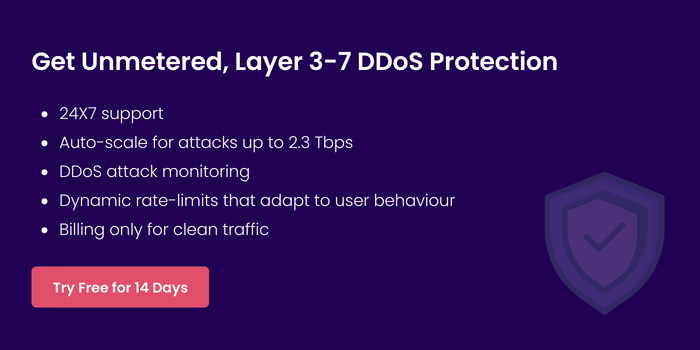No products in the cart.
DDoS attack protection encompasses strategies and measures aimed at defending against and mitigating the impact of DDoS attacks. While related, DDoS attack prevention specifically emphasizes proactive steps to minimize the likelihood of DDoS attacks.
DDoS attacks are not what they used to be 5-10 years ago. Earlier DDoS attacks were mostly Layer 3 or 4 – volumetric attacks that would attack the network or transport layers. Today, DDoS attacks are of many different types, and each type targets a different layer (network layer, transport layer, session layer, application layer) or combination of layers.
Further, attackers are finding new ways to make websites unavailable to legitimate traffic and lethal methods to exploit vulnerabilities, orchestrating highly sophisticated attacks.
Preventing DDoS attacks requires more than just increasing bandwidth or using standard firewalls. It demands a comprehensive, multi-layered protection approach that includes specialized defenses against application-layer DDoS attacks.
So, your solution must be scalable and have built-in redundancies, traffic monitoring capabilities, business logic flaw detection, and vulnerability management capabilities.
One common tactic attackers use is a DDoS botnet, a network of compromised devices controlled remotely to send a large volume of traffic to the target.
Let’s say your internal website (or database or any such resource), which is not open to the public, is down due to a DDoS attack.
What’s the catch?
No employee would possibly attack their own company asset. Hence, the possible chances are that a few of the employees’ systems are compromised and are being used as bots. So, the employees must be educated on how not to be exploited.
To avoid becoming part of a botnet, follow these steps:
By implementing these measures, you can reduce the risk of your devices being compromised and used in DDoS attacks, protecting both your assets and your organization’s reputation.
Your ability to identify the attack type before attackers is an integral part of the DDoS protection program. There are three frequent types of DDoS attacks that your business may encounter:
Layer 7, Application Layer or HTTP Flooding
This kind of application-layer attack targets an application with requests from multiple sources. Such attacks generate high volumes of POST, GET, or HTTP requests causing service downtime from hours to weeks. Layer 7 DDoS attack is widely used to bring down e-commerce, banking, and startup websites due to the low cost and ease of operation.
UDP Amplification
An attacker chokes the target server or network with open NTP request traffic. This traffic on Layer 3 or 4 (Network or Transport) is intensified with the payload traffic and is massive compared to the request size, hence overwhelming the service.
DNS Flooding
DNS flooding is a DDoS attack targeting the DNS (Domain Name System) servers that translate domain names into IP addresses. This attack aims to overwhelm the DNS servers with a large traffic volume, making it impossible for legitimate users to access the targeted website or online service.
By understanding each attack type’s characteristics and identifying them quickly, a DDoS protection program can respond in real time, effectively mitigating the attack before it causes significant damage.
Identifying the attack type allows for more targeted and effective defense mechanisms, such as filtering specific traffic or blocking malicious IP addresses. Additionally, early identification of the attack type can help predict and prevent future attacks and improve overall security posture.

Developing a DDoS attack threat model is essential for identifying and analyzing potential risks to your online service or website. Here’s a structured approach to create one:
Are all the web resources equal? What are the resources you want to be protected first?
Begin with specifying the priorities and criticality of your web resources for enhancing DDoS security. For example, business and data-centric web assets should be under the critical bucket with 24/7 DDoS protection.
A new priority bucket can be created for domains, networks, applications, and other services that are no longer used. Move them out of the business operation network as soon as possible.
To minimize the risk of DDoS attacks, it’s crucial to reduce the surface area exposed to attackers. Here are some effective strategies:
Network Segmentation: Separate and distribute assets within your network to make them harder to target. For instance, place web servers in a public subnet while keeping database servers in a private subnet. Also, restrict access to database servers from web servers, not other hosts.
Geographical Restrictions: Limit traffic to your website or application from specific countries where your users are located. This reduces exposure to potential attackers from regions where legitimate users are not expected.
Load Balancer Protection: Utilize load balancers to shield web servers and computational resources from direct exposure. By placing them behind a load balancer, you can distribute incoming traffic evenly and protect against DDoS attacks targeting specific servers.
Clean Application/Website: Keep your application or website clean by removing any unnecessary services, features, or legacy systems/processes. Attackers often exploit these entry points, so minimizing them reduces the attack surface and strengthens your defense against DDoS attacks.

| DDoS Attack Type | Metric | Category |
|---|---|---|
| Volumetric Attack | Bits per second (bps), Gigabits per second (Gbps), flood | Connectionless |
| Protocol Attack | Packets per second (PPS) | Connection-based |
| Application layer attack | Requests per second (RPS), low-rate | Connection-based |